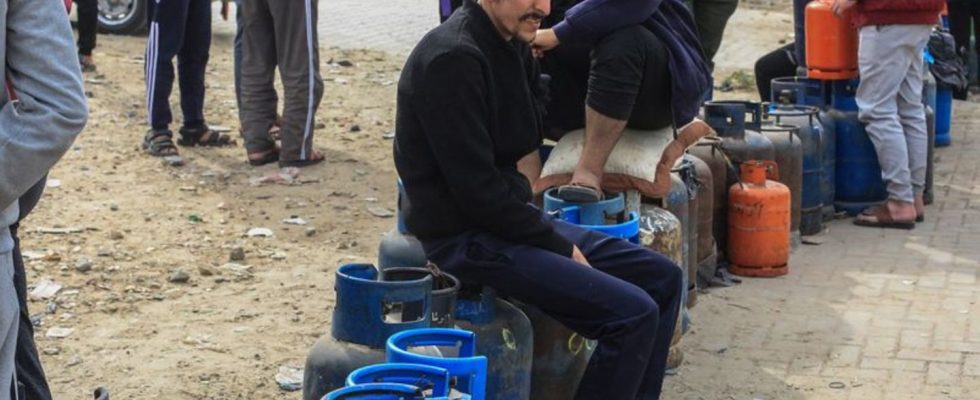With the hostage deal, Hamas and Israel have agreed to a short-term suspension of their fighting. The terrorist organization could benefit from this – in contrast to the Israeli army.
The agreement between Israel and Hamas is a blessing for the freed hostages and the suffering civilian population of the Gaza Strip – but it represents a setback for Israel’s military. “From a military point of view, it is an extremely unwelcome event,” says military historian Danny Orbach from the Hebrew University in Jerusalem, summarizing the ceasefire from the army’s perspective. “The biggest danger is that it loses its momentum.”
The military has continued to improve its strategy in recent weeks, explains Orbach. Interrupting the army’s mission would be like stopping a well-oiled machine. “It will be harder to get them going again.”
The break in fighting that came into effect on Friday was initially scheduled to last four days until Tuesday morning and could then perhaps be extended again. According to the agreement, military activities on both sides could even be suspended for a maximum of ten days.
Orbach: Hamas emerges stronger from break in fighting
Orbach emphasizes that Hamas will emerge stronger from the pause in fighting. “It’s a terrible dilemma for the Israeli government and Israeli society,” says Israel’s former deputy national security adviser, Eran Lerman, in Foreign Policy magazine. However, the army is able to resume fighting after the ceasefire.
Hamas will use the time to reorganize itself, said Orbach. At the same time, the Islamist organization will try to gain information about, among other things, the formation of the Israeli military. Hamas’s advantage is that its members can move relatively freely during the ceasefire without fear of attacks.
Israeli media also warn that Hamas will use the ceasefire to arm itself with the help of weapons smuggled from Egypt and to build up supplies from the aid supplies. Orbach assumes that the Islamist organization will also secure fuel, which will be delivered as part of the deal with the expanded transport of aid supplies.
The military historian also fears that Hamas could try to bring refugee residents back to the north via its tunnels. This would frustrate the army’s evacuation efforts, which would be able to fight more freely without the presence of civilians. “Hamas wants battles in densely populated areas because civilians are their defense strategy,” explains the military historian. The army repeatedly accuses Hamas of using civilians as protective shields.
Hundreds of people are returning to their homes
According to eyewitness reports, since the ceasefire began, hundreds of people have managed to get back from the south to their – largely destroyed – homes in the north. Many wanted to look for relatives, look at their home or get things. Israel’s military, which banned the return, used tear gas and sometimes live ammunition against Palestinians to prevent them from doing so.
Part of the agreement between the two warring parties is an exchange of up to 100 of the hostages held by Hamas in the Gaza Strip for up to 300 Palestinian inmates in Israeli prisons. The Islamist organization will therefore continue to have many of the approximately 240 people abducted from Israel as bargaining chips even after the break in fighting has ended.
Orbach assumes that the ceasefire should remain in place despite possible incidents. “Hamas has no interest in a break.” Rather, they will try to extend the break in fighting for as long as possible.
The terrorist organization hopes that Israel will gradually reduce its operations in the Gaza Strip through ceasefires and ultimately agree to a permanent ceasefire, writes the Israel Hayom newspaper. Despite many good results, Israel is far from achieving its war goals.
The shorter the ceasefire, the better for Israel’s army
After the unprecedented massacre on October 7, Israel’s army wants to destroy Hamas’ military capabilities and leadership in the Gaza Strip and bring all hostages home. The shorter the suspension of fighting, the better it is from the perspective of the Israeli army, explains military historian Orbach.
According to the army, Israeli soldiers will remain inside the Gaza Strip during the ceasefire. During this time, the military should concentrate on planning the next phases of the fight, emphasizes spokesman Daniel Hagari. According to Defense Minister Joav Galant’s wishes, the military should also deliver weapons during the “short respite.”
According to military expert Orbach, Israel’s forces are also trying to collect information about the enemy during this time. To do this, they used listening technology and binoculars. As a result of the deal, Israeli air surveillance is complete in the south of the coastal strip and suspended for six hours a day in the north.
After a ceasefire: Israel’s army wants to continue the campaign
The army is also strengthening its defense in the Gaza Strip by building barriers and entrenching itself in conquered areas. “From the Israeli army’s perspective, the disadvantages of the ceasefire outweigh the advantages,” sums up military historian Orbach. After the ceasefire, the army plans to continue its intensive campaign in the Gaza Strip for at least two more months, Defense Minister Galant announced.
A strengthened Hamas could then put Israeli soldiers in additional danger, Israeli media suspects. Orbach also assumes that once fighting resumes in the coastal area, significantly more Israeli soldiers will be killed than before. “Ultimately, you risk the soldiers’ lives to save those of the abductees.” But the military expert emphasizes that this sacrifice is worth it for the Israelis.
According to Orbach, the ceasefire is not really decisive for the outcome of the war. Israel could win the war as long as the pressure to conclude a permanent ceasefire does not become too great – be it from abroad or from the relatives of the hostages at home.

